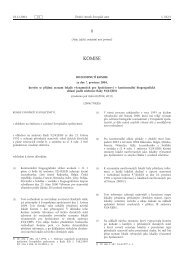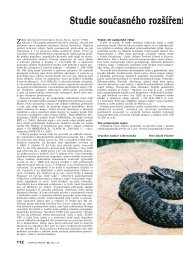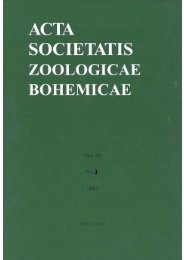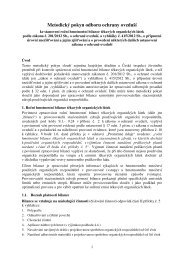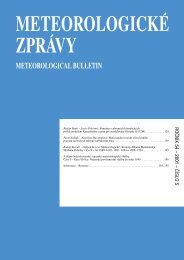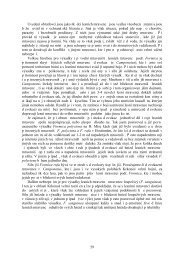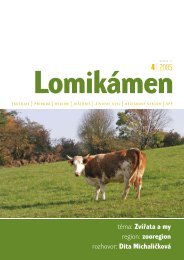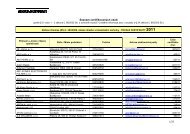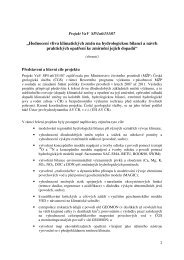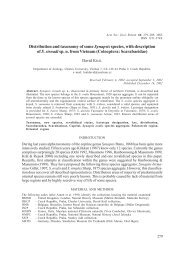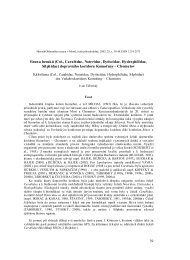journal of forest science
journal of forest science
journal of forest science
Create successful ePaper yourself
Turn your PDF publications into a flip-book with our unique Google optimized e-Paper software.
sistent or most efficient if the equations are simultaneous.<br />
The reason is that the method does not use the information<br />
on correlation between residuals <strong>of</strong> the remaining<br />
resultant estimators. VAN DEUSEN (1988) discussed the<br />
relationship <strong>of</strong> the minimization <strong>of</strong> error loss functions<br />
to the Seemingly Unrelated Regression (SUR) fitting<br />
technique, and showed that estimation based on minimizing<br />
squared error loss functions is very similar to the<br />
SUR techniques from econometrics, and suggested that<br />
if the system <strong>of</strong> equations belongs to the SUR framework,<br />
estimates <strong>of</strong> the structural parameters will be consistent<br />
and asymptotically efficient.<br />
The other method <strong>of</strong> simultaneous fitting techniques<br />
widely used in econometrics is the so-called system method.<br />
or the system <strong>of</strong> <strong>forest</strong>ry equations, URNIVAL and<br />
WILSON (1971) have considered it as the first application<br />
<strong>of</strong> econometric fitting techniques to <strong>forest</strong>ry systems<br />
to correct for simultaneity bias and contemporaneous<br />
correlation. Many other researchers have also discussed<br />
and used two and three-stage least squares (2SLS and<br />
3SLS), and SUR techniques from econometric methods<br />
to estimate the structural parameters in a system <strong>of</strong> <strong>forest</strong>ry<br />
equations (e.g. MURPHY 1983; AMATEIS et al.<br />
1984; BURKHART 1986; BORDERS, BAILEY 1986; REED<br />
1986; VAN DEUSEN 1988; BORDERS 1989; SOMERS,<br />
ARRAR 1991; LYNCH, MURPHY 1995; AMARO 1997;<br />
ZHANG et al. 1997). BORDERS (1989) discussed in detail<br />
three types <strong>of</strong> equation systems which are: (i) seemingly<br />
unrelated regression equations (SUR); (ii) recursive<br />
systems <strong>of</strong> equations; (iii) system <strong>of</strong> simultaneous equations,<br />
and described associated fitting methods in different<br />
types <strong>of</strong> equation systems, as well as an alternative<br />
parameter estimation procedure that can be used for any<br />
number <strong>of</strong> analytically related linear or non-linear equation<br />
systems.<br />
It is evident from the given examples that a wide variety<br />
<strong>of</strong> cases exists where the systems <strong>of</strong> related equations<br />
are used in <strong>forest</strong>ry. No single model can be expected to<br />
be the “best” for all the purposes that are practical, precise<br />
and common in <strong>forest</strong> prediction (BURKHART 1997).<br />
Therefore, when a growth and yield model is selected for<br />
<strong>forest</strong> prediction, one must think <strong>of</strong> a system <strong>of</strong> growth<br />
and yield models capable <strong>of</strong> providing logical and consistent<br />
estimates for varying degrees <strong>of</strong> stand details.<br />
Based on the idea, this study (i) analyzes a system <strong>of</strong><br />
three interdependent equations for predicting the future<br />
stand volume yield, the future stand dominant height and<br />
the future stand basal area for eucalyptus plantations as<br />
an integrated system given initial stand conditions;<br />
(ii) applies some statistical methods to simultaneously<br />
estimate the structural parameters <strong>of</strong> the system. The<br />
cross-equation correlations and simultaneous nature exist<br />
between the error components <strong>of</strong> these equations. No<br />
attention is paid to the fact that the error terms from related<br />
equations are almost certain to be correlated, and<br />
the available information on the cross-equation interdependence<br />
is not utilized; (iii) evaluates different system<br />
estimation methods for the system <strong>of</strong> nonlinear equations<br />
and compares them with the traditional single-equation<br />
technique based on OLS.<br />
SYSTEM O EQUATIONS<br />
VARIABLES O EQUATION SYSTEMS<br />
In systems <strong>of</strong> interdependent equations, the variables<br />
occurring on the left-hand side (LHS) are referred to as<br />
endogenous variables (or dependent variables). They are<br />
the system outputs and are assumed to be determined by<br />
the joint interaction with other variables within a system.<br />
These endogenous variables may also appear as predictor<br />
variables on the right-hand side (RHS) <strong>of</strong> equations<br />
within the system. All variables that only appear on the<br />
RHSs <strong>of</strong> the equations in the system are referred to as<br />
exogenous or predetermined variables that are determined<br />
outside the system.<br />
CLASSIICATIONS O EQUATION SYSTEMS<br />
Pindyck and Rubinfeld in 1981, as referenced in BOR-<br />
DERS (1989), classified the systems <strong>of</strong> related equations<br />
into three categories: (i) seemingly unrelated equations,<br />
(ii) recursive equations and (iii) simultaneous equations.<br />
The nature <strong>of</strong> each type <strong>of</strong> equation system is different<br />
and it is very useful to understand the nature <strong>of</strong> different<br />
systems <strong>of</strong> equations for fitting them.<br />
The types <strong>of</strong> structural models in different systems <strong>of</strong><br />
equations are discussed and described below. The position<br />
<strong>of</strong> the zero elements in the B matrix indicates which<br />
endogenous variables do not appear in different structural<br />
equations. This is used as a criterion for distinguishing<br />
between various types <strong>of</strong> structures <strong>of</strong> different equation<br />
systems.<br />
(i) System <strong>of</strong> seemingly unrelated equations:<br />
If B is diagonal, i.e., if:<br />
0 ......... 0<br />
0 B ...... 0<br />
22<br />
B = .<br />
.<br />
0 0.......... Bii Only one endogenous variable appears in each equation.<br />
This means that the equations are not simultaneous<br />
but seemingly related. A typical form <strong>of</strong> the seemingly<br />
unrelated equation system was discussed by BORDERS<br />
(1989). Obviously, there are no analytical relationships<br />
between equations if cov(e ,e ) = 0 for all pairs <strong>of</strong> error<br />
i j<br />
terms i and j. If cov(e ,e ) ≠ 0, then the equations are<br />
i j<br />
related. When such cross-equation correlations are<br />
present, a three-step fitting procedure discussed by REED<br />
(1986) may be desirable for parameter estimation <strong>of</strong> this<br />
type <strong>of</strong> equation system.<br />
Seemingly unrelated regression estimates are obtained<br />
by estimating a set <strong>of</strong> nonlinear equations with crossequation<br />
constraints imposed, but with a diagonal covariance<br />
matrix <strong>of</strong> the disturbances across equations. These<br />
286 J. FOR. SCI., 47, 2001 (7): 285–293<br />
B 11



